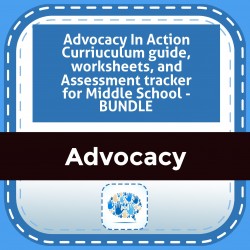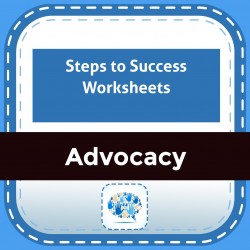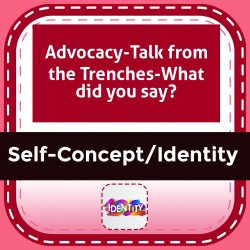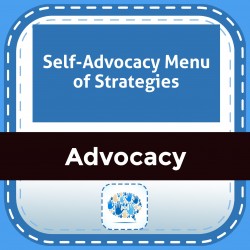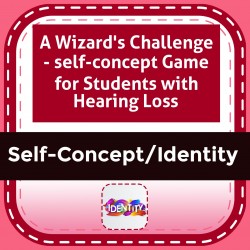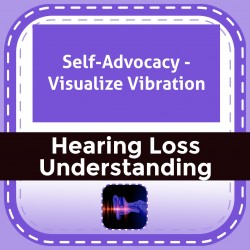Ability Levels
Categories
Resource Types
Age/Grade Range
CCSS
Anchor Standard
Speaking & Listening
Language
Reading
Advocacy In Action Curriuculum guide, worksheets, and Assessment tracker for Middle School - BUNDLE
$ 1695
Complete curriculum guidance, fillable sheets, activities and scenarios for instruction in understanding hearing loss (in themselves and other role models), assistive devices, and social awareness si
...
tuations. Also includes a a pre and post assessment skills tracker that can be used to determine strengths and needs, track skill acquisition, and create goals and objectives. Includes items 0527-0531, 0535, 0539, 0479, 0477
Steps to Success Worksheets
$ 35
A
companion piece to the Steps to Success Curriculum (ID# 1305), this bundle of
65 fill-in worksheets provided students with practice in key advocacy skills,
reading activities on both a basic and
...
advanced level and real-life language
development. The use of real photos, graphs and visual organizers support
retention of information and hold student’s interest. Goal area worksheets
address the following topics: 1. Understanding the science of hearing 2. Using
technology 3. Developing language processing skills 4. Self knowledge 5. Social
interaction and language 6. Practicing self-management 7.
Understanding rights and access 8. Accommodations and advocacy. Supplemental expansion worksheets for each goal are also available. See ID # 0740 - 0748.
Advocacy-Talk from the Trenches-What did you say?
$ 0
Engage teens in how missing information your friends and teachers say can make you feel left out. Start a discussion about how to repair communication mishaps. See BUNDLE at S0XSOC739.
Self-Advocacy Menu of Strategies
$ 250
List of self-advocacy strategies associated with responses on LIFE-R Student Assessment. Recommended activities and self-advocacy skills to use with the classroom teacher, friends, and requesting acco
...
mmodations. Overview to learning self-advocacy for students.
Hearing Tech - Tips to Help Me Better Hear and Understand
$ 0
This 2
page handout provides concise tips to help students who are hard of hearing
to fully access communication.
...
A Wizard's Challenge - Self-Concept Game for Students with Hearing Loss
$ 0
The Wizard's Challenge Game is a relevant and motivating resource which can be effectively used with students to reinforce standards based IEP goals and/or objectives in the areas of self-advocacy, se
...
lf-concept, communication repair and amplification utilization. The game relies on the players having some knowledge of the Harry Potter books or movies as it compares children with hearing loss living in families where they are the only ones who are deaf or hard of hearing to families of muggles that have a child who is a wizard or witch born into them. A parallel is drawn of Harry as 'The Boy Who Lived' being the only one with a lightening bolt scar on his face at Hogwarts to the student who is the only one using hearing devices in his or her neighborhood school. Print your own game board, cards, and game pieces.
Elephant in the Room Discussion Guide
$ 0
This
discussion guide is meant to accompany the book with prompts for each page.
...
Super Kena - A Girl Made Fierce with Hearing Aids
$ 995
“Super Kena – A Girl Made Fierce with Hearing Aids” is meant to empower children with hearing aids like Kena but also other “differently-abled” children who get teased and only want to fit in.The book
...
fit in.The book touches on children with glasses, with diabetes, who stutter, who have food allergies, with asthma, and who are in wheelchairs. Together they use their unique super powers to make a difference in the world by spreading understanding and acceptance . . . one classroom at a timeNOTE!!How to read Open EPUB or Open PDF e-books on a computer:Download the free Adobe Digital Editions: https://www.adobe.com/solutions/ebook/digital-editions/download.htmlOpen Adobe Digital Editions (ADE) on your Windows or Mac computer.Go to File > Add to Library.Find the saved EPUB or PDF file on your computer. By default, files are saved to your computer's "Downloads" folder.Double-click an e-book to start reading, or follow these steps to transfer it to an e-reader.Under top menu ‘Reading,’ select Double Page View
Self-Advocacy - Visualize Vibration
$ 0
Teach students about how vibration works with this activity and worksheet.
Advocacy in Action Curriculum Middle School
$ 850
Complete curriculum guidance and scenarios for instruction in understanding hearing loss (in themselves and other role models), assistive devices, and social awareness situations.
 Your browser is out of date. For best experience switch to latest updated Browser.
Your browser is out of date. For best experience switch to latest updated Browser.
 Get Chrome
Get Chrome Get Edge
Get Edge Get Firefox
Get Firefox